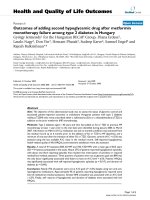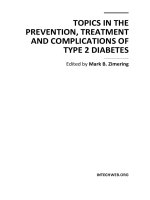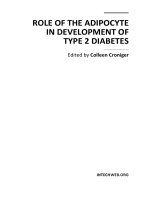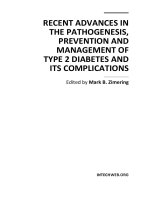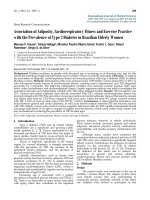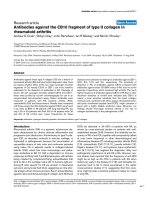The genetic basis of type 2 diabetes in a multi ethnic population in singapore
Bạn đang xem bản rút gọn của tài liệu. Xem và tải ngay bản đầy đủ của tài liệu tại đây (3.48 MB, 130 trang )
The genetic basis of Type 2 diabetes in a multi-ethnic
population in Singapore.
Jonathan Tan Tze Chong
(B.Sc (Hons I))
Submitted for the degree of Doctor of Philosophy
Department of Epidemiology and Public Health
Yong Loo Lin School of Medicine
National University of Singapore
2009
1
1. ACKNOWLEDGEMENTS
This thesis and indeed my journey as a PhD student would not have been possible or as
enriching without the contributions of many people. I would especially like to thank:
E-Shyong Tai, my mentor. I could not have wished for a better teacher. It has been an
absolute privilege and blessing to be able to work with you. I will never forget your untiring
patience, advice and encouragement. Your valuable insights about scientific methods and
also about life will always stay with me.
Kee Seng Chia, my supervisor. I thank you for luring me in the GAME PhD program. It has
been the most enjoyable and rich education I have had. Thanks for always being there
when I needed help and advice.
Jeannette Lee, Thank you for your friendliness, providing grant support for my studies and
reminding me of the fun side of life!
Maudrene Tan, my co-author and friend. It has been a pleasure working with you and I am
thankful for your patience in always helping with my statistical questions.
Xue Ling Sim and Gek Hsiang Lim, my colleagues and friends. Thank you both for all your
statistical advice and for being the best travel mates!
Edmund Chan, fellow PhD student, lab manager and friend. Thank you for always assisting
me in procuring samples and supplies and the numerous candid conversations which made
lab work easier to bear.
Thanks also to all colleagues at the Department of Epidemiology and Public Health for help
and support and creating a friendly atmosphere.
Queenie, Mom and Dad, thank you for everything.
2
2. ABSTRACT
Type 2 diabetes occurs when the body is unable to regulate blood glucose levels as a result
of insulin resistance and impaired insulin secretion. Type 2 diabetes mellitus exhibits
significant heritability and the aim of my research is to examine the basis of this heritability.
In the first study, we evaluate the effect of a family history of type 2 diabetes on risk of type
2 diabetes and related metabolic traits. We found that subjects with a positive family
history had an increased risk of developing type 2 diabetes with an odds-ratio of 2.25 (95%
CI: 1.85 2.75). This increased risk appears to be mediated through increased obesity,
-cell dysfunction.
The year 2007 brought the advent of genome wide association studies, which lead to
the identification of over a dozen novel type 2 diabetes susceptibility loci. As these initial
studies were carried out in populations of European ancestry, the relevance of these genetic
variants in Asian populations remain less well-characterized. To gain a greater appreciation
of the genetic basis of type 2 diabetes in Asians, we have investigated the association
between recently identified type 2 diabetes susceptibility loci with risk of diabetes in the
Chinese, Malay and Asian-Indian populations in Singapore. We also examined their
associations with traits that appear to be involved in the pathogenesis of type 2 diabetes;
-cell dysfunction.
In the second study, we examine the effect of genetic variants at the FTO locus in the
Singapore Chinese and Malay populations. We found statistically significant association
between FTO variants with type 2 diabetes which appeared to be mediated through its
effect on BMI (p=10
-4
10
-6
).
In the third study, to characterize the effect of a newly identified susceptibility locus
(KCNQ1), we investigate the association between polymorphisms at the locus with
quantitative traits relevant to the pathogenesis of type 2 diabetes. We found that the
increased risk for type 2 diabetes associated with KCNQ1 is likely through a reduction in
-cell function/insulin secretion (p=0.013).
In the fourth study, we examine the effects of genetic variants at eight type 2
diabetes susceptibility loci (CDKAL1, CDKN2A/B, IGF2BP2, HHEX, SLC30A8, PKN2,
LOC387761) and conduct a meta-analysis with studies in East Asians. This study
demonstrated that type 2 diabetes susceptibility loci identified through genome wide
association studies in populations of European ancestry show similar effects in East Asian
populations. This suggest that failure to detect these effects across different populations
are likely due to issues of power owing to limited sample size, lower minor allele frequency,
or differences in genetic effect sizes.
Our studies examined several type 2 diabetes susceptibility loci and demonstrate a
genetic basis/predisposition of type 2 diabetes in Asians. As several groups worldwide are
currently undertaking re-sequencing studies to identify causative variants at these loci, the
examination of multiple ethnic groups may allow us to exploit differences in the patterns of
linkage disequilibrium between ethnic groups, in order to refine the genomic region of
interest and aid in this effort. While many susceptibility loci continue to be identified, much
of the disease variability still remains unaccounted for; further studies examining gene-
environment interaction as well as a more detailed interrogation of human genetic variation
will provide further insight to the genetics of type 2 diabetes.
3
3. LIST OF PUBLICATIONS
This thesis is based on the following four publications:
I. Tan JT, Tan LS, Chia KS, Chew SK, Tai ES.
A family history of type 2 diabetes is associated with glucose intolerance and
obesity-related traits with evidence of excess maternal transmission for obesity-
related traits in a South East Asian population.
Diabetes Research & Clinical Practice. 2008 Nov;82(2):268-75. (Impact factor 1.9)
II. Tan JT, Dorajoo R, Seielstad M, Sim XL, Ong RT, Chia KS, Wong TY, Saw SM, Chew SK,
Aung T, Tai ES.
FTO variants are associated with obesity in the Chinese and Malay populations in
Singapore.
Diabetes. 2008 Oct;57(10):2851-7. (Impact factor 8.4)
III. Tan JT, Nurbaya S, Gardner D, Ye S, Tai ES, Ng DP.
Genetic variation in KCNQ1 associates with fasting glucose and beta-cell function: a
study of 3,734 subjects comprising three ethnicities living in Singapore.
Diabetes. 2009 Jun;58(6):1445-9. (Impact factor 8.4)
IV. Tan JT, Ng DP, Nurbaya S, Ye S, Lim XL, Wong TY, Saw SM, Aung T, Chia KS, Lee J,
Chew SK, Seielstad M, Tai ES.
Meta-analysis of GWAS identified Type 2 diabetes susceptibility loci in East Asian
populations.
Journal of Clinical Endocrinology and Metabolism. 2010 Jan;95(1):390-7.
(Impact factor 6.3)
Other publications related to this thesis:
V. Tan JT, Chia KS, Ku CS.
The molecular genetics of type 2 diabetes: past, present and future.
Encyclopaedia of Life Sciences. 2009 John Wiley & Sons Ltd, Chichester.
( DOI: 10.1002/9780470015902.a0021994
VI. Tan JT, Ng DP, Nurbaya S, Ye S, Lim XL, Wong TY, Saw SM, Aung T, Chia KS, Lee J,
Chew SK, Seielstad M, Tai ES.
Association of GWAS identified type 2 diabetes susceptibility loci in the Chinese,
Malay and Asian-Indians in Singapore.
Presented at the inaugural Asian Association for the Study of Diabetes in Osaka,
Japan (2009).
4
4. TABLE OF CONTENTS
1. Acknowledgements • 1
2. Abstract • 2
3. List of publications • 3
4. Table of contents • 4
5. Abbreviations • 5
6. Introduction • 6
7. Background • 8
7.1 Pathogenesis of type 2 diabetes • 8
7.2 Heritability of type 2 diabetes • 10
7.3 The complexity of the genetics of type 2 diabetes • 12
7.4 Direct versus indirect association • 19
7.5 Type 2 diabetes susceptibility loci selected for study • 20
8. Aims • 24
9. Study populations • 26
9.1 The 1998 Singapore National Health Survey • 26
9.2 The Singapore Diabetes Cohort Study • 29
9.3 The Singapore Malay Eye Study • 30
10. Study design and methods • 32
10.1 Study I • 32
10.2 Study II • 34
10.3 Study III • 36
10.4 Study IV • 38
11. Results • 40
11.1 Clinical characteristics of study participants • 40
11.2 Study I • 42
11.3 Study II • 16
11.4 Study III • 51
11.5 Study IV • 54
12. Discussion • 60
12.1 Methodological considerations • 60
12.2 Bias • 61
12.3 Fixed effects versus random effects model • 70
13. Findings and implications • 72
13.1 Study I • 72
13.2 Study II • 75
13.3 Study III • 76
13.4 Study IV • 80
14. Conclusions • 82
15. Future studies • 84
16. References • 87
17. Published papers • 98
5
5. ABBREVIATIONS
The following abbreviations have been used in this thesis:
BMI Body mass index
CIR
120
Corrected insulin response at 120 minutes
GWAS Genome-wide association studies
HWE Hardy-Weinberg equilibrium
IFG Impaired fasting glucose
IGT Impaired glucose tolerance
IR Insulin resistance
LD Linkage disequilibrium
MAF Minor allele frequency
MODY Maturity onset of diabetes in the young
NGT Normal glucose tolerance
NHS98 1998 Singapore National Health Survey
OR Odds ratio
RR Relative risk
SDCS Singapore Diabetes Cohort Study
SiMES Singapore Malay Eye Study
SNP Single nucleotide polymorphism
T2DM Type 2 diabetes mellitus
WHR Waist to hip ratio
6
6. INTRODUCTION
Type 2 diabetes mellitus (T2DM) affects more than 170 million individuals worldwide, and
this has been projected to increase to over 360 million by 2030
1
. Although lifestyle factors
such as diet and physical activity contribute to the development of T2DM, genetic factors
are also important in the pathogenesis of T2DM. Over the course of my studies, the ease of
genotyping has increased while the cost has continued to decrease. This is clearly illustrated
(and indeed reflected by the studies in this thesis too) with the progression of studies
examining a single polymorphism, to fine-mapping studies examining several
polymorphisms within a gene, to studies examining polymorphisms across many different
genes and genome wide association studies.
However, as T2DM is a common, heterogeneous and polygenic disease, it would be
erroneous to think that the genetic variance of this disease might be explained by a few
genes. Quite the opposite actually, as illustrated by the recent explosion of genetic
association studies each touting new T2DM susceptibility loci. Unfortunately, the gold
standard for validation, replication in a separate study population, often falls short.
Nonetheless, several novel T2DM susceptibility loci, identified by recent genome-wide
association studies (GWAS), have shown consistent replication across different populations.
However, as most of these initial studies were carried out in populations of European
ancestry, the importance of these genetic variants in relation to T2DM susceptibility remains
less well-characterized in Asian populations.
Singapore, where my studies were carried out, is a highly developed country in
Southeast Asia with a population of ~4.5 million. Despite ethnic and cultural differences
with Western countries, the prevalence rate of T2DM in Singapore (~9%) is comparable to
those in the United States and Europe. Singapore has a multi-ethnic population comprising
7
mainly Chinese, Malays and Asian-Indians. These three ethnic groups represent the
predominant portion of the population resident in Asia; where the prevalence of T2DM is
expected to double in the next 20 years as a result of the rapid urbanization occurring in this
region
1
. The Malay ethnicity alone is the third largest ethnic group in Asia with a total
population of over 200 million in Indonesia, Malaysia, Singapore and other Southeast Asian
countries. This ethnic group certainly represents a population with the propensity to
develop T2DM and have a prevalence of T2DM of 8.5% in men and 10.1% in women in
Singapore
2
. However, to-date, the genetic susceptibility to T2DM in the Malays has not
been examined.
In this thesis, we begin by examining the impact of a family history of diabetes; to
further assess the genetic basis of type 2 diabetes, we next examine the contribution of
recently identified novel T2DM susceptibility loci on the risk of T2DM in the Chinese, Malays
and Asian-Indians in Singapore.
8
7. BACKGROUND
7.1. PATHOGENESIS OF TYPE 2 DIABETES
regulate blood glucose levels. The key hormone for blood glucose regulation is insulin,
-cells in the pancreas, in response to the absorption of glucose
from food. Type 1 diabetes is characterized as an insulin deficiency syndrome, while T2DM,
which accounts for ~90% of all diabetes cases, was considered a result of insulin resistance.
However, it is now evident that the pathogenesis of T2DM comprises two components,
-cell dysfunction
3
.
Insulin resistance is present when the biological effect of insulin (i.e. suppression of
glucose production in the liver and glucose disposal in muscles) is lessened. Normally, as
insulin sensitivity decreases-cells are able to adapt and up-regulate insulin secretion,
maintaining relatively normal blood glucose levels. Consequently, -cell dysfunction
(through the inability to produce sufficient insulin) is critical in the pathogenesis of T2DM.
At some stage during the pathogenesis of T2DM, the -cell fails to compensate for insulin
resistance and blood glucose levels rise (Figure 1). This increase in blood glucose over time
can cause glucose toxicity which in turn further -cells
3
. Accordingly, factors
-cell function or glucose levels are considered risk factors
for diabetes.
9
Adapted from International Diabetes Center (IDC), Minneapolis, Minnesota.
Figure 1. Pathogenesis of type 2 diabetes, showing the progression from normal glucose tolerance
to the pre-diabetic state of impaired fasting glucose (IFG) and impaired glucose tolerance (IGT)
leading to type 2 diabetes.
10
7.2. HERITABILITY OF TYPE 2 DIABETES
The heritability of T2DM is demonstrated by the high concordance among monozygotic
twins (~70%) as compared to dizygotic twins (~30%)
4
, as well as the familial clustering of the
disease.
7.2.1. Family history of type 2 diabetes
Several studies have shown that a positive family history of T2DM is associated with an
increased risk of the disease, where individuals with a first degree relative with T2DM have
a 15-25% chance of developing diabetes. Interestingly, a positive family history of T2DM is
not only associated with an increased risk of T2DM
5-7
but also with the presence of other
risk factors such as increased body mass index (BMI) and blood glucose
8, 9
, and decreased
insulin secretion
10
. Consistent with this, recent data from several GWAS have identified
genetic variants associated with increased risk of T2DM, which encode obesity (e.g. FTO),
insulin resistance (e.g. PPARγ) -cell function (e.g. KCNJ11, TCF7L2, KCNQ1,
CDKAL1, HHEX-IDE)
11-14
, the three key components in the pathogenesis of T2DM.
7.2.2. Differential parental transmission of type 2 diabetes risk
The heritability of T2DM and its related traits are complicated by an apparent excess
maternal transmission
5, 6, 15-18
. In the prospective study over 22.5 years by Bjornholt et al.
6
,
compared to subjects with non-diabetic parents, subjects with a diabetic mother had a
higher risk of developing T2DM (RR=2.51, p=0.0002), while subjects with a diabetic father
had a non-statistically significant increase in risk (RR=1.41, p=0.376).
One implication of a differential effect between maternal and paternal family history
of T2DM is that, when conducting genetic association studies of T2DM or diabetes-related
traits (e.g. obesity, dyslipidemia), it may be important to ascertain the maternal and
11
paternal transmission of the risk alleles. Failing to do so could result in a reduction in the
effect observed potentially leading to an underestimation of the risk associated with a
particular allele, or failure to detect the association with the allele at all.
7.2.3. Effect of a family history of type 2 diabetes in Asian populations
While several studies in European populations have shown that a positive family history of
T2DM increases risk of T2DM, the impact of a family history of T2DM, and the pattern of
transmission in Asian populations has not been extensively studied.
One study in Malaysia found that a parental history of T2DM was associated with
higher WHR
19
. However, this was a small study comprising 60 pre-pubertal Malay children
and did not examine the role of paternal versus maternal transmission. Another study
carried out in Chinese living in Hong Kong
18
found that patients with T2DM were more likely
to have a diabetic mother than a diabetic father, suggesting that the excess maternal
transmission observed in Caucasian populations may apply in Asian ethnic groups too.
However, as the study included only subjects with T2DM, they were unable to determine
the effect of a positive family history on the risk of developing T2DM. Furthermore, these
studies were unable to determine the impact of family history of T2DM on other diabetes
related traits among normal glucose tolerant individuals.
In complex disorders such as T2DM, it is often difficult to tease apart the genetic and
environmental contributions to the familial clustering. Studies have shown that levels of
environmental risk factors for diseases such as obesity, physical activity and diet
20, 21
are
correlated among family members. However, a simulation study by Khoury et al.
22
concluded that it is unlikely that simple familial clustering of common environmental factors
alone could account entirely for familial aggregation of diseases. Instead, genetic factors
12
(with possible interaction with environmental factors) are most likely the cause of familial
aggregation of diseases.
7.3. THE COMPLEXITY OF THE GENETICS OF TYPE 2 DIABETES
Genetic studies of diseases have traditionally relied on two methods to discover the
responsible genes: linkage mapping and candidate gene studies. Genetic studies of T2DM
initially employed the linkage mapping approach, however, when the limitations of linkage
studies to identify common, low risk genetic determinants of T2DM became apparent,
candidate gene studies superseded as the preferred study design. Nonetheless, both
methods have shown some success in the identification of susceptibility loci (Table 1).
Gene
SNP
Overall
OR (95%CI),
p-value
Protein Function
Putative
Mechanism
Ref.
CAPN10
rs2975760
(SNP -44)
1.17 (1.07-1.29),
p=7x10
-4
Cystein protease
Unclear
23, 24
TCF7L2
rs7903146
1.46 (1.421.51),
p=5.4×10
Transcription factor
-cell dysfunction
25, 26
PPARγ
rs1801282
(Pro12Ala)
0.81 (0.75-0.88),
p=1.5x10
-7
Transcription factor
Insulin sensitivity
27, 28
KCNJ11
rs5219
(Glu23Lys)
1.23 (1.12-1.36),
p=1.5x10
-5
Potassium channel
-cell dysfunction
29
HNF1β
rs757210
1.12 (1.071.18),
p=5x10
-6
Transcription factor
Beta-cell function &
development
30
WSF1
rs10010131
0.90 (0.86-0.93),
p=1.4x10
-7
Wolframin, membrane
glycoprotein
-cell function &
survival
31
Table 1. T2DM susceptibility loci identified through linkage or candidate gene studies.
13
7.3.1 Linkage studies of type 2 diabetes
Linkage mapping is conducted using related individuals (e.g. pedigrees, sibling pairs) and
uses polymorphic genetic markers spaced across the genome (e.g. microsatellites) to detect
regions of chromosomes that co-segregate with the disease phenotype (measured using log
odds (LOD) score analysis). Genomic regions that are present more frequently than
expected among subjects with a particular phenotype are further interrogated in detail (e.g.
sequencing, positional cloning) to isolate the causative gene.
The use of linkage analysis in genetic studies of rare, monogenic forms of diabetes,
such as maturity-onset diabetes of the young (MODY) have been relatively successful in
identifying the aberrant genetic variants. To date, six MODY genes (HNF4α, GCK, HNF1α,
PDX1, HNF1β and NEUROD1) have been identified and account for ~85% of all MODY
cases
32
. In contrast, the linkage mapping approach has not proved as effective in identifying
the genetic determinants of the more common and multifactorial type 2 diabetes. One
reason for this is that linkage analysis is better designed and powered for the study of
diseases where one or a few highly penetrant genes are involved, and where multiple
disease cases are present in the pedigree. On the contrary, T2DM is a polygenic disease
with many possible genes, each contributing a modest effect with additional gene-gene and
gene-environment interactions adding further complexity to the analysis. Nonetheless, a
few diabetes susceptibility genes showing robust association have been identified using the
linkage approach.
Calpain-10 (CAPN10) was the first T2DM gene identified using linkage analysis
23
.
CAPN10 is located on chromosome 2 and encodes a cysteine protease, subsequent studies
have shown the association of several single nucleotide polymorphisms (SNPs) in CAPN10
with increased risk of T2DM
24, 33
. More recently, another T2DM susceptibility gene
identified through linkage analysis is the transcription factor-7-like 2 gene (TCF7L2)
25
. To-
14
date, TCF7L2 has shown to confer the greatest effect on T2DM risk (meta-analysis OR of
1.46, p<10
-140
)
26
.
7.3.2. Candidate gene association studies of type 2 diabetes
Following the limited success of family-based linkage approach in the detection of T2DM
susceptibility loci, researchers realized that large-sample epidemiological association studies
may be better designed to discover genetic susceptibility loci
34
. One of the complicating
factors is the clinical heterogeneity of T2DM. The dichotomous diagnosis of T2DM is based
on glucose levels, however this does not differentiate between the numerous possible
underlying physiological or genetic alterations for the abnormal glucose levels. In this
respect, the use of genetic association studies would also allow the analysis of quantitative
-cell function and obesity to facilitate the
identification and characterization of T2DM susceptibility genes.
Candidate genes are selected based on knowledge of their biological involvement in
T2DM. Initial candidate gene studies were largely constrained by the relatively inefficient
and expensive genotyping methods available at the time, and the lack of public databases
and depositories of genetic information (i.e. Human Genome Project, HapMap).
Nonetheless, several T2DM susceptibility genes were discovered and showed consistent
replication across different populations (Table 1). Some of the more notable ones are the
genes encoding the peroxisome proliferator- PPARγ), the potassium
channel Kir6.2 (KCNJ11) and the wolframin protein (WSF1).
PPARγ is a transcriptional factor that is activated by certain fatty acids, prostanoids,
and more interestingly, is the molecular target of thiazolidinesdione medications. A
missense mutation results in a Proline Alanine change at position 12 (P12A), and is
15
associated with decreased risk of T2DM (OR=0.79, p<10
-4
)
35
likely through increased insulin
sensitivity
27
.
KCNJ11 encodes the ATP-sensitive potassium channel Kir6.2, together with the
sulfonylurea receptor SUR1 (ABCC8), it regulates glucose-stimulated insulin secretion in
-cells. A missense mutation in KCNJ11 results in a glutamate lysine change at
position 23 (E23K), which has been shown to be significant association with increased risk of
T2DM (OR=1.23, p=1.5x10
5
)
29
. Subsequent studies have also implicated the E23K variant
with decreased insulin secretion
36
. The association between ABCC8 polymorphisms with
T2DM has been less consistent, with a large cohort study and meta-analysis finding no
association with T2DM
29
.
Genes known to be involved in MODY were also selected as T2DM candidate genes.
Of the six known MODY genes, only one (HNF1β) showed a conclusive association with
T2DM (OR=1.12, p=5x10
-6
)
30
. In support of this finding, previous studies had shown that
mutations in HNF1β lead to abnormal regulation of transcription in -cells, causing a defect
in metabolic signalling of -cell mass
32
.
Rare mutations in the gene WSF1 causes defects in its encoded protein (Wolframin),
which results in the Wolfram syndrome. In particular, Wolfram syndrome is characterized
by diabetes insipidus and juvenile diabetes, making it a plausible candidate gene for T2DM.
A large candidate gene association study in the U.K. comprising 9,533 cases and 11,389
controls subjects found significant association between common SNPs (minor allele
frequency (MAF) >40%) at the WSF1 loci with risk of T2DM
31
. This study also illustrated an
important shortfall of the candidate gene-approach; with 1536 SNPs in 84 T2DM candidate
-cell development, growth and function,
remarkably, only one showed significant association, underscoring a key limitation of
16
candidate gene studies; that they are restricted by our limited biological knowledge of the
pathogenesis of the disease, precluding the discovery of novel disease markers/pathways.
7.3.3. Genome-wide association studies
Genome-wide association studies (GWAS) employ the unbiased interrogation of
polymorphisms across the entire genome to identify statistical association between genetic
variants and phenotypes. In contrast to linkage studies, they are usually carried out in
unrelated individuals, and unlike candidate gene studies, they do not require any prior
supposition of the biological function of genes or pathogenesis of the disease. Advances in
genotyping technologies have been responsible for the feasibility of such studies.
Commercially available genotyping arrays by Illumina® (San Diego, California, USA) and
Affymetrix® (Santa Clara, California, USA) enable researchers to genotype up to one million
SNPs per sample. These technological advances coupled with: (1) the decreasing cost of
genotyping (much less than 5% compared to a decade ago); (2) the construction of the
International HapMap database to identify haplotype-tagging SNPs (increases genotyping
efficiency by reducing the number SNPs required to account for genetic variation in regions
of strong linkage disequilibrium (LD)); and (3) the development of methodologies to analyze
and interpret the large datasets have been critical in driving the rapid publications of GWAS.
In 2007, five large genome-wide association studies of the genetics of T2DM were
carried out
12, 37-40
. The findings from these GWAS corroborated the association with known
genes (i.e. TCF7L2, KCNJ11 and PPARγ), as well as revealing several novel T2DM
susceptibility genes (SLC30A8, HHEX, CDKAL1, IGF2BP2 and CDKN2A/B) (Table 2). The
GWAS by the Welcome Trust Case Control Consortium (WTCCC) also reported that genetic
variants in the FTO gene were associated with T2DM, however this was found to be a
consequence of its effect on BMI
11
. More recently, two independent GWAS in Japan
17
identified a novel T2DM susceptibility locus (KCNQ1), this finding was corroborated by
replication in European and East Asian populations
41, 42
.
Gene
SNP
Overall
OR (95%CI),
p-value
Protein Function
Putative
Mechanism
Key
References
SLC30A8
rs13266634
1.15 (1.12-1.19),
p=1x10
-19
-cell zinc transporter
Insulin storage
and secretion
38, 43
HHEX
rs1111875
1.15 (1.10-1.19),
p=1x10
-17
Transcription factor
Pancreatic
development
38, 43
CDKAL1
rs7754840
1.15 (1.03-1.28),
p=4.1x10
-10
Homologous to CDK5
inhibitor (CDK5RAP1)
Islet response
to glucotoxicity
39
IGF2BP2
rs4402960
1.17 (1.10-1.25),
p=7.5x10
-8
IGF2 mRNA binding protein
Pancreatic
development
12, 37, 40
CDKN2A/B
rs10811661
1.20 (1.14-1.25),
p=8x10
-15
Cyclin-dependent kinase
inhibitor
Islet development
12, 37, 40
FTO
rs9939609
1.19 (1.131.25),
p=1.3x10
-11
2-oxoglutarate-dependent
nucleic acid demethylase
Alters BMI, may
influence appetite
11
LOC387761
rs7480010
1.14 (1.01 - 1.27),
p=2.9x10
-4
Hypothetical gene
Unknown
38
PKN2
rs6698181
1.11 (1.05-1.16),
p=5.3x10
-5
Protein kinase
Regulation of
-cells
40
JAZF1
rs864745
1.10 (1.07-1.13),
p=5x10
-14
Transcriptional repressor
Associated with -
cell function
44, 45
CDC123-
CAMK1D
rs12779790
1.11 (1.07-1.14),
p=1.2x10
-10
Cell cycle/protein kinase
Associated with -
cell function
44, 45
TSPAN8-
LGR5
rs7961581
1.09 (1.06-1.12),
p=1.1x10
-9
Cell surface glycoprotein
Associated with -
cell function
44, 45
THADA
rs7578597
1.15 (1.10-1.26),
p=1.1x10
-9
Thyroid adenoma protein
Known to associate
with PPARγ
44, 45
ADAMTS9
rs4607103
1.09 (1.06-1.12),
p=1.2x10
-8
Secreted metalloprotease
Expressed in
pancreas, may be
involved in apotosis
44, 45
NOTCH2
rs10923931
1.13 (1.08-1.17),
p=4.1x10
-8
Transmembrane receptor
Expressed during
pancreatic
organogenesis
44, 45
KCNQ1
rs2237897
1.33 (1.24-1.41),
p<1x10
-16
Potassium channel
-
cell function
41, 42
Table 2. T2DM susceptibility loci identified through GWAS.
18
One particular advantage of GWAS in the study of complex disorders is that it allows
the discovery of susceptibility loci without the need of prior knowledge of the putative gene
function or location. However, the modest effect sizes conferred by common variants, and
the need for stringent statistical thresholds limit statistical power of studies, denote the
need for larger sample sizes. Power calculations of a meta-analysis of three early GWAS,
comprising almost 10,000 subjects, showed that the power to discover variants with an
effect size of OR<1.2 (which appears to be the norm for T2DM susceptibility loci, with the
exception of TCF7L2) is relatively low (Figure 2), indicating that a large portion of
susceptibility loci remains undetected
46
.
Figure 2. Power estimates of the DIAGRAM meta-analysis to detect genetic associations
of OR=1.1–1.4 across various risk allele frequencies. (From Florez et al.
46
)
19
In an effort to boost study power to detect additional T2DM susceptibility loci with
lower effects (OR<1.2), the Diabetes Genetics Replication and Meta-analysis (DIAGRAM)
45
consortium combined the results from three GWAS (FUSION group, WTCCC and Diabetes
Genetics Initiative (DGI)). Following meta-analysis, replication testing of promising loci
identified (p<10
-4
) was carried out in about 50,000 independent subjects. This exercise
yielded an additional six loci (JAZF1, CDC123-CAMK1D, TSPAN8-LGR5, THADA, ADAMTS9,
and NOTCH2-ADAM30) (Table 2), which showed association with T2DM at the genome-wide
statistical significance threshold (p<10
-8
).
Interestingly, most of these GWAS-identified loci appear to be associated with
insulin secretion, rather than insulin resistance. One explanation for this may be in the
study design of the GWAS. In the attempt to focus on genetic variants which predispose to
T2DM independent of BMI, the GWAS by Sladek et al.
38
, limited T2DM cases to those with a
BMI of <30kg/m
2
, while the GWAS by the Diabetes Genetics Initiative matched cases and
controls by BMI
40
. Thus by controlling for BMI, which in turn is highly correlated with insulin
resistance, these studies were more likely to detect genetic variants associated with insulin
-cell function rather than insulin resistance related to adiposity. Another
possible reason is that measures of insulin secretion appear to be more heritable than
insulin resistance
47, 48
, suggesting that insulin resistance may have a larger environmental
component and may have fewer genetic determinants with more modest effects.
7.4. DIRECT VERSUS INDIRECT ASSOCIATION
With the exception of certain monogenic diseases (e.g. cystic fibrosis, thalassaemia), in
which direct association with the function/causative mutation has been demonstrated,
most of the known association between genetic variants and diseases are indirect. Indirect
association studies (e.g. GWAS) rely on LD between the genetic markers examined with the
20
causative variant or haplotype, allowing the detection of causal variants that have not been
identified. Indirect association is not without its limitations, for example, incomplete LD
between the marker and the causative loci reduces study power. In addition, it is crucial
that the SNPs genotyped account for most of the genetic variation at the locus in order for a
negative association to be credible
49
. Accordingly, much work has been done to optimize
indirect association studies. For example, the International HapMap Project was initiated to
develop a haplotype map of the human genome, providing information on genomic
variation and LD structure in different ethnicities. This information facilitates the selection
of haplotype-tagging SNPs for the efficient screening for disease association at putative loci.
However, as information on genomic variation reaches saturation and with the increasing
ease of sequencing, it will be feasible for association studies to examine all variation within
and around the putative locus, including the causal variant.
7.5. TYPE 2 DIABETES SUSCEPTIBILITY LOCI SELECTED FOR STUDY
One of the main objectives of this thesis is to investigate and validate the effects of T2DM
susceptibility loci in the Chinese, Malay and Asian-Indian populations in Singapore. We have
focused on T2DM susceptibility loci identified by the initial GWAS in 2007
12, 37-40
(FTO,
SLC30A8, HHEX, CDKAL1, IGF2BP2, CDKN2A/B, PKN2 and LOC387761), in addition to KCNQ1,
which was more recently identified by GWAS in Japan
41, 42
.
21
7.5.1. FTO
FTO) was first characterized by researchers when the deletion in a
homologous region in mice resulted in fused toes (FT) and other (O) abnormalities
50
.
Subsequently, the FTO gene has been referred to as the fat mass and obesity-related gene,
after the GWAS by WTCCC
11
identified the association between FTO with T2DM, through its
effect on body mass.
Obesity is an established risk factor for T2DM and accounts for some of the
heritability of T2DM risk, it is also strongly associated with insulin resistance. Adipose tissue
modulates metabolism by releasing hormones (e.g. adiponectin), cytokines and non-
esterified fatty acids (NEFAs). In obesity, NEFAs are increased and have been shown to
-cell function, possibly due to interference with the
insulin-signalling pathway
51
. As such, genes associated with obesity are relevant for the
study of the genetic basis of T2DM. Several genes (e.g. PPARγ, Leptin, MC4R) have also
been shown to be significantly associated with both T2DM and obesity
51
.
Although robust replication of the association between variants at FTO locus with
BMI has been observed in several populations of European ancestry
52-56
, this association is
less consistent in populations of non-European ancestry. In particular, the association of
FTO variants with obesity was not observed in Chinese from Beijing and Shanghai
57
,
although it was observed to be associated in the Japanese
58
. One possible explanation for
this discrepancy could be gene-environment interactions, with one study in Denmark
reporting that physical activity attenuated the effects of the FTO variants on obesity
52
.
Therefore, it is of interest to examine if this locus is associated with obesity and T2DM in the
Chinese, Malay and Asian-Indian population resident in Singapore, and if the association
might be modulated by exercise.
22
7.5.2. KCNQ1
More recently in 2008, two independent GWAS in Japan
41, 42
identified SNPs (rs2237892,
rs2237895, rs2237897 and rs2283228) within a novel T2DM susceptibility gene, KCNQ1,
which were strongly associated with T2DM in the Japanese population. This association was
further corroborated in a Danish cohort and in the Singapore Chinese population. KCNQ1
encodes the pore--subunit of the I
KS
K
+
channel and is expressed in the pancreas
where it is co-expressed with products of other regulators such as KCNE1
59
. As such, it is
plausible that polymorphisms within the KCNQ1 gene alter the properties and role of I
KS
K
+
channel, affecting -cell function and insulin production. Of the two initial
studies, Unoki et al.
41
did not examine the -cell function or insulin
resistance, while the study by Yasuda et al.
42
reported an -cell function in
Japanese (p=0.021) and Finnish subjects (p=0.024).
To further our understanding of the association between KCNQ1 with T2DM, it is
important to examine the association between these genetic variants with quantitative
-cell function, insulin
resistance). The understanding of the pathophysiological effects of T2DM susceptibility loci
is important to pave the way for the identification of new approaches for the treatment of
T2DM.
23
7.5.3. T2DM GWAS identified susceptibility loci - CDKAL1, CDKN2A/B, IGF2BP2, HHEX,
SLC30A8, PKN2, LOC387761
T2DM susceptibility loci identified through GWAS (CDKAL, CDKN2B, IGF2BP2, HHEX,
SLC30A8, PKN2, LOC387761)
12, 37-40
, have been well examined in populations of European
descent as well as in independent Japanese studies
58, 60
. However, the role of these loci in
other Asian populations remains less clear. For example, a study in China by Wu et al.
61
did
not find significant associations between SNPs in IGF2BP2 and SLC30A8 with T2DM, while an
association between SNPs at the HHEX locus and T2DM was reported among Chinese living
in Shanghai, but not among Chinese in Beijing. Another study in Hong Kong Chinese
62
also
did not find an association with SNPs at the IGF2BP2 locus, however, they reported an
association between T2DM with SNPs at the HHEX and SLC30A8 loci. Consequently, it is
important to fill this knowledge gap and establish a consensus as to the relevance and
contribution of these recently identified T2DM susceptibility loci in Asian populations. We
also examined rs6698181 in PKN2 as it did showed some association in the GWAS by DGI
and FUSION (p=10
-3
-10
-5
)
37, 40
, and rs7480010 in LOC387761 which showed an association in
the GWAS by Sladek et al. (p=10
-5
)
38
. As there have been fewer reports examining these
loci, we felt it might be of interest to examine this in our multi-ethnic population.
24
8. AIMS
The overall objective of this thesis is to examine the genetic basis of type 2 diabetes in the
Chinese, Malay and Asian-Indian population living in Singapore. To this end, we have
examined several different facets of type 2 diabetes (i.e. Familial clusteri-cell function
and obesity/IR), as illustrated in Figure 3 below:
Figure 3. Overview of the four studies in this thesis, in the context of the type 2 diabetes
pathogenesis framework.

